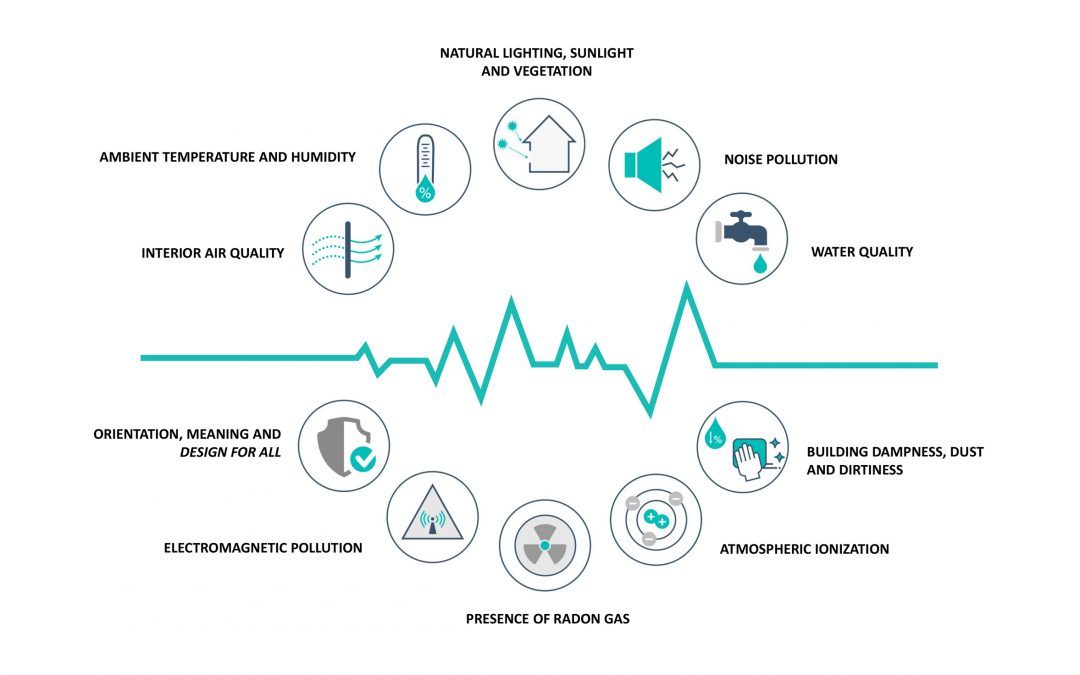SEVILLE / 16 September 2022.
After the well-deserved and warm summer break, we are resuming the long-awaited series on Healthy Architecture launched last January, in which we are exposing the genesis of this new paradigm that contemporary society is demanding in an imperative and unpostponable way.
In this new issue we propose a compendium of ten specific aspects that must be taken into account in the design and construction of buildings to combat the symptoms of the sick building (SBS) and stimulate the presence of assets in buildings and cities, in a way that favours and benefits human health. It is a Decalogue for Healthy Architecture, developed by the Healthy Architecture & City research group of the University of Seville, which was presented for the first time in February 2020. There are ten important factors to be considered in architectural projects, based on environmental stresses that influence and affect the health and well-being of people. These ten points are as follows:
I. Indoor Air Quality or Indoor Air Quality (IAQ). The most effective way to control air quality is through adequate and essential natural ventilation in all spaces. Air quality is perceived by breathing and, basically, through the eyes, nose and skin. The combined reaction of the organism determines whether the air is perceived as fresh and pleasant or as stale and irritating. To guarantee air quality, both natural ventilation and the choice of construction materials must be taken into account, prescribing those that are innocuous, with low emission of volatile organic compounds and verifying the absence of pollutants such as lead, PCBs, asbestos, etc.
II. Ambient temperature and humidity.The relationship between these two parameters is very important for human well-being; the homeostasis of the organism depends on them, among other factors.Measures must be taken to ensure a suitable combination of temperature and humidity in living and working environments throughout the year.It must be a combination of parameters adapted to the atmospheric conditions of each place, since there are no fixed parameters that can be applied equally and uniformly in all places, due to the fact that the sensation of comfort depends both on people and on the climatic and geographical circumstances of each area, so it is essential to study and establish at a local level a specific range of optimum levels suitable both for energy efficiency and for the comfort and health of people.
III. Natural lighting, sunlight and green areas. Interior spaces should have as much natural light as possible, maintaining visual comfort and avoiding glare.Diagonals and visual lines from the interior to the exterior should be provided, trying to introduce the vision of areas with vegetation or open green spaces, an aspect that has a significant impact on the mental and emotional wellbeing of people.In addition, spaces with controlled sunlight at certain times of the day are necessary, but without going as far as Dr. Saidman’s revolving sanatorium, built in Aix-les Bains (France) in the mid 1930s.IV. Noise pollution.It is important to control unwanted noise pollution by protecting and insulating interior rooms from outside noise such as traffic.The sound of church bells and the chirping of roosters at dawn are not noise pollution; they are articulated sounds with meaning and significance, one is symbolic and the other natural. It is also necessary to monitor the emission of internal sources of noise that can be annoying such as mechanical equipment, household appliances, air conditioning machinery, lifts or the neighbour rehearsing for the next concert.
IV. Noise pollution. It is important to control unwanted noise pollution by protecting and insulating interior rooms from outside noise such as traffic. The sound of church bells and the chirping of roosters at dawn are not noise pollution; they are articulated sounds with meaning and significance, one is symbolic and the other natural. It is also necessary to monitor the emission of internal sources of noise that can be annoying such as mechanical equipment, household appliances, air conditioning machinery, lifts or the neighbour rehearsing for the next concert.
V. Water quality. Contaminants in drinking water must be eliminated as much as possible. To this end, in addition to the actions already taken by the water supply companies, it is advisable to install domestic purification systems to further improve water quality. Water stagnation in drains, buildings and outdoor areas should be prevented, and stagnant water in wells, puddles, etc. should be avoided, as they favour the appearance of pests. When eliminating pests, the use of pesticides and chemical products should be limited, so, whenever possible, it is better to anticipate their appearance by eliminating their source.
VI. Damp in buildings and dirt. It is essential to avoid the presence of damp due to rising damp, condensation or infiltration in buildings. Their existence favours the presence of fungi and bacteria that are harmful to health. Also avoid materials and spatial distributions which, due to their characteristics and shapes, favour dirt or the appearance of reactions and allergies.
VII. Atmospheric ionisation. Clean air is normally negatively ionised, an adequate percentage of negative ions contributes to a feeling of well-being, hence the expression “pure air of nature”. The air in cities is normally charged with positive ions, as is the air inside buildings. The concentration of negative ions in the air is lowered by air circulating through metal ducts, tobacco smoke, static electricity generated by synthetic fibres and human activities. This has been linked to discomfort, lassitude, stress and loss of mental and physical capacity. Maintaining the right amount of negative ions in the environment is an important factor to consider.
VIII. Presence of radon gas. Radon (Rn) is a natural gas produced by the decay of radium belonging to the radioactive decay chain of uranium-238. It is present in the earth’s crust and dissolves in water, so radon can be found anywhere, although it is most commonly found in granitic soils and in soils containing uranium ore. Building materials such as phosphorous gypsum or blocks made from pieces of granite can also contribute radon. This gas penetrates by natural diffusion up to a maximum height of one metre, through joints between materials, cracks or the passage of ducts, so it is necessary to avoid its concentration. This aspect is controlled and regulated in Spain by DB-HS 6 of the CTE.
IX. Electromagnetic pollution. Although numerous studies have been carried out on electromagnetic fields (EMF), the effects of prolonged exposure to fields generated by power lines, telephone antennas or other fields created by household appliances and work equipment have not yet been demonstrated by scientific evidence and clinical trials. Nor is it proven that these fields are the cause of SBS-related fatigue, stress or depression. However, as a preventive measure until verified data is available, it seems important to plan and design these essential contemporary infrastructures with appropriate isolation and at adequate distances from living and working places.
X. Clear orientation, rational distribution and maximum safety. It is necessary to contemplate the safety standards that refer to carbon monoxide detection, falls, fire safety, etc., but above all it is necessary to observe the seven principles of Design for All or Universal Design, trying to achieve complete accessibility for people with functional diversity, whether physical, sensory or cognitive, as we explained in the section dedicated to Cognitive Accessibility in buildings, environments and cities.
The way to address the above points does not seem to be through expensive technological solutions aimed at further conditioning environments and/or creating artificial climates. Architecture has the capacity to use materials that can be recycled, to control the energy savings of its buildings, to preserve energy sources and to monitor the ecological footprint of products; it also has the power to build by adapting to the climatic conditions of the environment, taking advantage of the sun’s energy with processes of capture, accumulation and controlled radiation, achieving natural conditioning and ventilation. Architecture has the instruments and resources to resolve all these requirements effectively. But, above all, architecture has to excite.
It is about facing these new social challenges with a different way of thinking. It is about designing by applying a new architectural model that produces an architecture that generates emotion and is also healthy. An architectural vision that can be summarised theoretically in five basic points that we will explain in detail in the next issue.
——
Santiago Quesada-García is Dr. Architect, University Professor, Head Researcher of the Healthy Architecture & City group (TEP-965) and Principal Investigator of the ALZARQ project of the Ministry of Science and Innovation and DETER of the Andalusian Regional Government.
Post published in the Bulletin of the IUACC nº 147 of September 16, 2022


